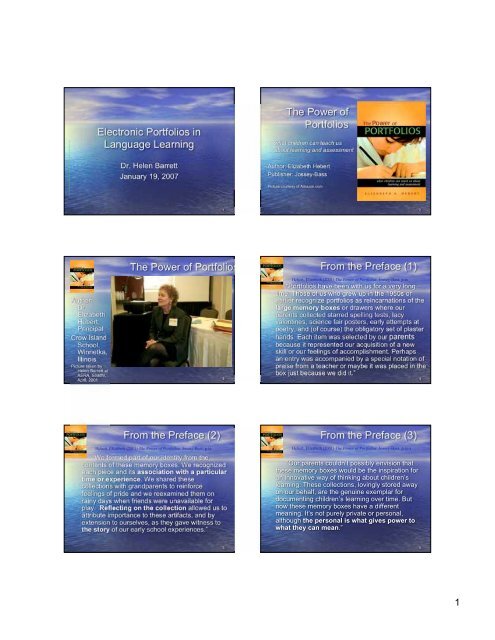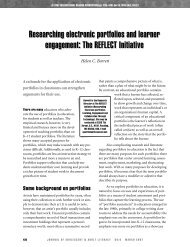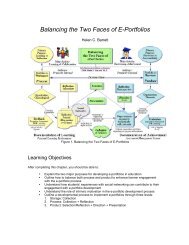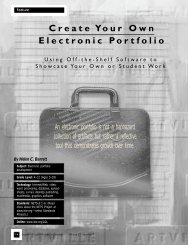Electronic Portfolios in Language Learning The Power of Portfolios ...
Electronic Portfolios in Language Learning The Power of Portfolios ...
Electronic Portfolios in Language Learning The Power of Portfolios ...
You also want an ePaper? Increase the reach of your titles
YUMPU automatically turns print PDFs into web optimized ePapers that Google loves.
<strong>Electronic</strong> <strong>Portfolios</strong> <strong>in</strong><br />
<strong>Language</strong> Learn<strong>in</strong>g<br />
Dr. Helen Barrett<br />
January 19, 2007<br />
<strong>The</strong> <strong>Power</strong> <strong>of</strong><br />
<strong>Portfolios</strong><br />
what children can teach us<br />
about learn<strong>in</strong>g and assessment<br />
Author: Elizabeth Hebert<br />
Publisher: Jossey-Bass<br />
Picture courtesy <strong>of</strong> Amazon.com<br />
1<br />
2<br />
<strong>The</strong> <strong>Power</strong> <strong>of</strong> <strong>Portfolios</strong><br />
From the Preface (1)<br />
Author:<br />
Dr.<br />
Elizabeth<br />
Hebert,<br />
Pr<strong>in</strong>cipal<br />
Crow Island<br />
School,<br />
W<strong>in</strong>netka,<br />
Ill<strong>in</strong>ois<br />
Picture taken by<br />
Helen Barrett at<br />
AERA, Seattle,<br />
Hebert, Elizabeth (2001) <strong>The</strong> <strong>Power</strong> <strong>of</strong> <strong>Portfolios</strong>. Jossey-Bass, p.ix<br />
“<strong>Portfolios</strong> have been with us for a very long<br />
time. Those <strong>of</strong> us who grew up <strong>in</strong> the 1950s or<br />
earlier recognize portfolios as re<strong>in</strong>carnations <strong>of</strong> the<br />
large memory boxes or drawers where our<br />
parents collected starred spell<strong>in</strong>g tests, lacy<br />
valent<strong>in</strong>es, science fair posters, early attempts at<br />
poetry, and (<strong>of</strong> course) the obligatory set <strong>of</strong> plaster<br />
hands. Each item was selected by our parents<br />
because it represented our acquisition <strong>of</strong> a new<br />
skill or our feel<strong>in</strong>gs <strong>of</strong> accomplishment. Perhaps<br />
an entry was accompanied by a special notation <strong>of</strong><br />
praise from a teacher or maybe it was placed <strong>in</strong> the<br />
box just because we did it.”<br />
3<br />
4<br />
April, 2001<br />
From the Preface (2)<br />
Hebert, Elizabeth (2001) <strong>The</strong> <strong>Power</strong> <strong>of</strong> <strong>Portfolios</strong>. Jossey-Bass, p.ix<br />
“We formed part <strong>of</strong> our identity from the<br />
contents <strong>of</strong> these memory boxes. We recognized<br />
each piece and its association with a particular<br />
time or experience. We shared these<br />
collections with grandparents to re<strong>in</strong>force<br />
feel<strong>in</strong>gs <strong>of</strong> pride and we reexam<strong>in</strong>ed them on<br />
ra<strong>in</strong>y days when friends were unavailable for<br />
play. Reflect<strong>in</strong>g on the collection allowed us to<br />
attribute importance to these artifacts, and by<br />
extension to ourselves, as they gave witness to<br />
the story <strong>of</strong> our early school experiences.”<br />
From the Preface (3)<br />
Hebert, Elizabeth (2001) <strong>The</strong> <strong>Power</strong> <strong>of</strong> <strong>Portfolios</strong>. Jossey-Bass, p.ix-x<br />
“Our parents couldn’t possibly envision that<br />
these memory boxes would be the <strong>in</strong>spiration for<br />
an <strong>in</strong>novative way <strong>of</strong> th<strong>in</strong>k<strong>in</strong>g about children’s<br />
learn<strong>in</strong>g. <strong>The</strong>se collections, lov<strong>in</strong>gly stored away<br />
on our behalf, are the genu<strong>in</strong>e exemplar for<br />
document<strong>in</strong>g children’s learn<strong>in</strong>g over time. But<br />
now these memory boxes have a different<br />
mean<strong>in</strong>g. It’s not purely private or personal,<br />
although the personal is what gives power to<br />
what they can mean.”<br />
5<br />
6<br />
1
Let’s get personal…<br />
Th<strong>in</strong>k for a m<strong>in</strong>ute about:<br />
Someth<strong>in</strong>g about your COLLECTIONS:<br />
Suggested topics:<br />
• If you are a parent, what you saved for<br />
your children<br />
• What your parents saved for you<br />
• What you collect…<br />
• Why you collect…<br />
7<br />
Some issues to consider<br />
• What do your collections say about what<br />
you value?<br />
• Is there a difference between what you<br />
purposefully save and what you can’t<br />
throw away?<br />
• How can we use our personal collections<br />
experiences to help learners as they<br />
develop their portfolios?<br />
<strong>The</strong> power <strong>of</strong> portfolios [to support deep learn<strong>in</strong>g] is personal.<br />
8<br />
What is a Portfolio <strong>in</strong><br />
Education?<br />
A portfolio is a purposeful collection<br />
<strong>of</strong> student work that exhibits the<br />
student's efforts, progress and<br />
achievements <strong>in</strong> one or more areas<br />
[over time].<br />
(Northwest Evaluation Association, 1990)<br />
9<br />
What is a Portfolio <strong>in</strong> Education?<br />
(2)<br />
<strong>The</strong> collection must <strong>in</strong>clude:<br />
• student participation <strong>in</strong><br />
select<strong>in</strong>g contents<br />
• the criteria for selection<br />
• the criteria for judg<strong>in</strong>g merit<br />
• evidence <strong>of</strong> student selfreflection<br />
(Northwest Evaluation Association, 1990)<br />
10<br />
Why use <strong>Portfolios</strong>?<br />
Parent Questionnaire Rat<strong>in</strong>gs <strong>of</strong> the Usefulness <strong>of</strong> Different Types<br />
<strong>of</strong> Information for Learn<strong>in</strong>g about <strong>The</strong>ir Child’s Progress <strong>in</strong> School<br />
• provides a richer picture <strong>of</strong><br />
student performance than<br />
can be ga<strong>in</strong>ed from more<br />
traditional, objective forms<br />
<strong>of</strong> assessment<br />
11<br />
Source: After Shepard & Bliem, 1995, p. 27<br />
12<br />
2
What is an <strong>Electronic</strong> Portfolio?<br />
• uses electronic technologies as the<br />
conta<strong>in</strong>er<br />
• which allows students/teachers to collect<br />
and organize portfolio artifacts <strong>in</strong> many<br />
media types (audio, video, graphics, text)<br />
• us<strong>in</strong>g hypertext l<strong>in</strong>ks to organize the<br />
material<br />
• connect<strong>in</strong>g evidence to appropriate<br />
standards (<strong>in</strong> a standards-based portfolio)<br />
13<br />
Traditional<br />
• Collect<strong>in</strong>g<br />
• Select<strong>in</strong>g<br />
• Reflect<strong>in</strong>g<br />
• Direct<strong>in</strong>g<br />
• Celebrat<strong>in</strong>g<br />
Portfolio Processes<br />
+ Technology<br />
• Archiv<strong>in</strong>g<br />
• L<strong>in</strong>k<strong>in</strong>g/Th<strong>in</strong>k<strong>in</strong>g<br />
• Storytell<strong>in</strong>g<br />
• Collaborat<strong>in</strong>g<br />
• Publish<strong>in</strong>g<br />
14<br />
Def<strong>in</strong>itions<br />
• Artifact: a piece <strong>of</strong> student work<br />
• Captions: brief explanatory reflection<br />
on a piece <strong>of</strong> work <strong>in</strong> a portfolio<br />
• Evidence <strong>of</strong> Learn<strong>in</strong>g <strong>in</strong> a Portfolio<br />
Artifact<br />
+ Reflection (Student’s Rationale)<br />
+ Validation (Teacher’s Evaluation)<br />
3 General Components <strong>of</strong> the<br />
Portfolio Development Process<br />
• Content:<br />
– Learner’s artifacts and reflections (captions)<br />
• Purpose<br />
– Reason for creat<strong>in</strong>g the portfolio <strong>in</strong>clud<strong>in</strong>g learn<strong>in</strong>g,<br />
pr<strong>of</strong>essional development, assessment, employment<br />
• Process<br />
– Tools used<br />
– Sequence <strong>of</strong> activities<br />
– Rules established by educational <strong>in</strong>stitution<br />
– Reflections a learner constructs <strong>in</strong> develop<strong>in</strong>g the portfolio<br />
– Evaluation criteria<br />
– Collaboration or conversations about the portfolio<br />
15<br />
16<br />
Purpose & Goals for the portfolio<br />
(Determ<strong>in</strong>e Content)<br />
• Multiple purposes:<br />
–Learn<strong>in</strong>g/Process<br />
–Assessment<br />
–Market<strong>in</strong>g/Showcase<br />
17<br />
Learn<strong>in</strong>g <strong>Portfolios</strong><br />
• “know thyself” = a lifetime <strong>of</strong> <strong>in</strong>vestigation<br />
• self-knowledge as outcome <strong>of</strong> learn<strong>in</strong>g<br />
Documentation<br />
Reflection<br />
Learn<strong>in</strong>g<br />
Portfolio<br />
<strong>The</strong> Learn<strong>in</strong>g Portfolio<br />
(Zubizaretta, 2004,<br />
p.20)<br />
Collaboration<br />
18<br />
3
Learn<strong>in</strong>g <strong>Portfolios</strong><br />
• Support reflection which is central to learn<strong>in</strong>g<br />
• Reflections<br />
– <strong>The</strong> Heart and Soul <strong>of</strong> the Portfolio<br />
• An electronic portfolio without reflection is just a<br />
– Digital scrapbook<br />
– Fancy electronic resume<br />
– Multimedia Presentation<br />
– Personal web site<br />
Showcase <strong>Portfolios</strong><br />
• Market<strong>in</strong>g<br />
• Employment<br />
• Tell your story<br />
• A primary motivator for many<br />
portfolio developers<br />
19<br />
20<br />
Assessment <strong>Portfolios</strong><br />
Purposes for Assessment<br />
• A major movement <strong>in</strong> Teacher<br />
Education <strong>in</strong> U.S.<br />
• A major new commercial<br />
market<br />
• A primary motivator for<br />
organizations<br />
Assessment OF<br />
Learn<strong>in</strong>g<br />
=<br />
Summative<br />
Assessment<br />
Assessment FOR<br />
Learn<strong>in</strong>g<br />
=<br />
Formative<br />
(Classroom-based)<br />
Assessment<br />
More later! 21<br />
22<br />
Authentic Assessment<br />
• where students generate<br />
• rather than choose a response<br />
• “<strong>The</strong> terms alternative assessment, authentic<br />
assessment, or performance-based assessment<br />
are <strong>of</strong>ten used synonymously "to mean variants<br />
<strong>of</strong> performance assessments that require<br />
students to generate rather than choose a<br />
response" (Herman, Aschbacher, and W<strong>in</strong>ters, 1992, p. 2).<br />
ePortfolio Technology over Time<br />
Conta<strong>in</strong>er<br />
• 1991: Desktop<br />
• 1995: CD-R<br />
• 2000: Internet<br />
• 2005: DVD-R<br />
• 2006: Pocket<br />
Tech (PDAs,<br />
Flash drives,<br />
Phones, iPods)<br />
• What’s Next?<br />
Author<strong>in</strong>g S<strong>of</strong>tware<br />
• Common tools<br />
– Office & PDF<br />
– HTML Editors<br />
• Customized Systems<br />
– Onl<strong>in</strong>e data bases<br />
– Work Flow Management<br />
– Assessment Management<br />
• Interoperability (currently<br />
<strong>in</strong> “silos”)<br />
23<br />
24<br />
4
• Work<strong>in</strong>g Portfolio<br />
– <strong>The</strong> Repository<br />
– <strong>The</strong> Digital Archive<br />
– <strong>The</strong> Artifacts<br />
(meta-tagged)<br />
– Personal<br />
Information<br />
– Reflective Journal<br />
Levels <strong>of</strong> ePortfolio<br />
Implementation<br />
• Presentation<br />
Portfolio(s)<br />
– <strong>The</strong> “Story” or<br />
Narrative<br />
– Multiple Views<br />
(public/private)<br />
– Varied Audiences<br />
(permissions)<br />
– Varied Purposes<br />
25<br />
What is the best<br />
tool?<br />
It Depends!<br />
26<br />
State <strong>of</strong> the Art <strong>of</strong> e-Portfolio<br />
Development<br />
• Publish<strong>in</strong>g environments:<br />
– Optical media (CD-R, DVD-R)<br />
– WWW<br />
• Author<strong>in</strong>g environments:<br />
– Common Tools<br />
– Customized (Commercial) Systems<br />
– Open Source Tools<br />
– Web 2.0 Technologies<br />
27<br />
Plann<strong>in</strong>g Issues<br />
• What is your purpose?<br />
– authentic assessment (formative feedback)<br />
– showcas<strong>in</strong>g best work and growth over time<br />
• S<strong>of</strong>tware capabilities: allow <strong>in</strong>teraction<br />
between teachers and students around<br />
learn<strong>in</strong>g activities and products:<br />
– Students: create, store artifacts and reflections<br />
and organize their work, preferably with<br />
hyperl<strong>in</strong>ks<br />
– Teachers: review the work and provide feedback<br />
<strong>in</strong> narrative form (based on a rubric, if available)<br />
• Internet access? Poor or good?<br />
28<br />
Poor Internet Access?<br />
• Micros<strong>of</strong>t Office<br />
– Word<br />
– Excel<br />
– <strong>Power</strong>Po<strong>in</strong>t<br />
• Other Options:<br />
Apple iLife06<br />
– iDVD, iWeb<br />
Today’s Tool Choices<br />
• Web Page Editors<br />
(DreamWeaver, Front Page)<br />
<strong>The</strong>se tools do not require<br />
Internet access to create<br />
electronic portfolios.<br />
Good Internet Access?<br />
• TaskStream, iWebFolio<br />
or any commercial fee-based<br />
system<br />
• OSP & Sakai<br />
• Web 2.0 tools<br />
<strong>The</strong>se tools require only a<br />
browser and good Internet<br />
access to create electronic<br />
portfolios because they are<br />
Application Services Providers<br />
(ASP) - the s<strong>of</strong>tware is on the<br />
company server.<br />
29<br />
Advantages<br />
• On most personal<br />
computers<br />
• Common toolset<br />
• Easy to create<br />
hyperl<strong>in</strong>ks<br />
• Easy to add comments<br />
• Does not require<br />
Internet access to<br />
develop portfolios<br />
(students work <strong>of</strong>f-l<strong>in</strong>e)<br />
Better for publish<strong>in</strong>g on CD<br />
Office - Word, Excel,<br />
<strong>Power</strong>Po<strong>in</strong>t<br />
Disadvantages<br />
• Set up own system for<br />
stor<strong>in</strong>g and organiz<strong>in</strong>g files,<br />
and manag<strong>in</strong>g the feedback<br />
on student work (probably<br />
us<strong>in</strong>g Track Changes <strong>in</strong><br />
Word or Comments <strong>in</strong> all<br />
tools)<br />
• Data aggregation must be<br />
set up by teacher with<br />
another tool, like Excel, not<br />
automated<br />
• Files should be translated<br />
<strong>in</strong>to Web-compatible format<br />
before post<strong>in</strong>g onl<strong>in</strong>e (HTML<br />
or PDF)<br />
30<br />
5
Advantages<br />
• Free, <strong>of</strong>ten opensource<br />
tools on the<br />
WWW<br />
• “Me Publish<strong>in</strong>g<br />
• Shared<br />
Resources<br />
• Shared Writ<strong>in</strong>g<br />
• Media Creation<br />
Onl<strong>in</strong>e<br />
Web 2.0 Technologies<br />
Disadvantages<br />
• Requires higher<br />
technology<br />
competency<br />
• Mostly not secure<br />
websites<br />
“Small Pieces, Loosely Jo<strong>in</strong>ed”<br />
31<br />
Lifetime Personal<br />
Web Space<br />
ePortfolio “Mash-up”<br />
ePortfolio “Mash-up”<br />
Small pieces, loosely jo<strong>in</strong>ed<br />
32<br />
Architecture <strong>of</strong> Interaction<br />
(Web 2.0)<br />
allows a<br />
Pedagogy <strong>of</strong> Interaction<br />
(ePortfolio 2.0)<br />
Digital Evidence <strong>of</strong> Writ<strong>in</strong>g<br />
• Word process<strong>in</strong>g documents<br />
• Blogs: Blogger.com<br />
• Shared Writ<strong>in</strong>g<br />
– Wiki - wikispaces.com<br />
– GoogleDocs<br />
33<br />
34<br />
Digital Evidence <strong>of</strong> Speak<strong>in</strong>g<br />
• Shared Video<br />
– YouTube.com<br />
• Onl<strong>in</strong>e Video<br />
Creation:<br />
– Bubbleshare.com<br />
– Jumpcut.com<br />
• Podcasts<br />
Onl<strong>in</strong>e Audio<br />
Creation:<br />
– Odeo.com<br />
– Podomatic.com<br />
35<br />
Free Onl<strong>in</strong>e Portfolio Tools<br />
• Blog with pages<br />
www.wordpress.com<br />
• Free onl<strong>in</strong>e portfolio for edu addresses<br />
www.epsilen.com<br />
• KEEP Toolkit<br />
www.cfkeep.org<br />
• GoogleDocs<br />
docs.google.com/<br />
36<br />
6
For more details:<br />
Authentic Assessment with<br />
<strong>Electronic</strong> <strong>Portfolios</strong> us<strong>in</strong>g Common<br />
S<strong>of</strong>tware and Web 2.0 Tools<br />
http://electronicportfolios.org/web20.html<br />
“every day-ness”<br />
How can we make ePortfolio<br />
development a natural process<br />
<strong>in</strong>tegrated <strong>in</strong>to everyday life?<br />
Lifelong and Life Wide Learn<strong>in</strong>g<br />
37<br />
38<br />
My F<strong>in</strong>al Wish…<br />
Dr. Helen Barrett<br />
May all your<br />
electronic portfolios<br />
become dynamic<br />
celebrations and stories<br />
<strong>of</strong> deep learn<strong>in</strong>g<br />
across the lifespan.<br />
39<br />
• Research Project Director,<br />
<strong>The</strong> REFLECT Initiative<br />
sponsored by TaskStream<br />
• eportfolios@comcast.net<br />
• http://electronicportfolios.org/<br />
40<br />
7






